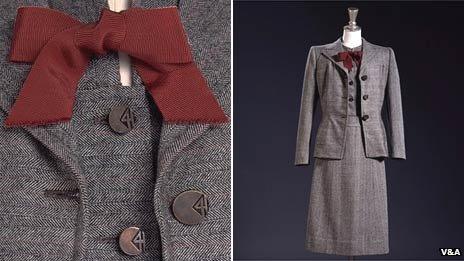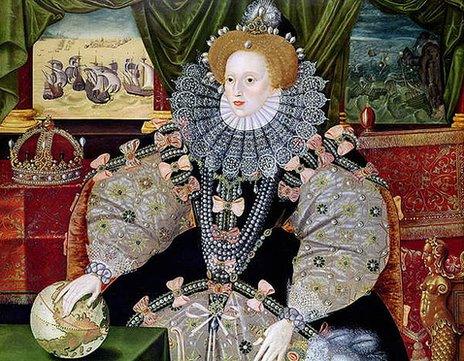A Point of View: Dazzling in an age of austerity
- Published
- comments

Stylised buttons show the wartime regulations were being followed
History often harks back to dazzling moments rather than day-to-day drabness, argues historian Lisa Jardine.
2011 will be remembered as the year that ushered in a new age of austerity. From 4 January, when VAT increased from 17.5 to 20%, we all felt that little bit less well off, and things got worse as the year wore on.
For my generation, "austerity" is a word with a very particular ring to it, permanently associated with the rationing regulations introduced during World War II.
Sweet rationing did not end until 1953, and I have intense childhood memories of my mother counting out our scanty sweet allocation from a biscuit tin on the kitchen draining board once a week. It is probably why I am also of the generation that has an irresistibly sweet tooth to this day.
Clothes rationing had a particularly dramatic effect on how women of Britain looked in the 1940s. Items of clothing were identified by the CC41 label (civilian clothing 1941), guaranteeing that they conformed to the government's frugality regulations.
In 1942 the Making of Civilian Clothing (restriction order) was passed. This prohibited wasteful cutting of cloth, and set a list of restrictions that tailors and dressmakers had to work to. Dresses could have no more than two pockets and five buttons, six seams in the skirt of a woollen dress, two inverted or box pleats, or four knife pleats. No unnecessary decoration was allowed.
Yet, if 2011 began the age of austerity, it was also the year of Prince William and Catherine Middleton's glorious Royal Wedding. And that had everything to do with glamour and opulence - especially the wedding dress, lovingly designed in total secrecy by Sarah Burton, successor at the fashion house of Alexander McQueen. No economising there - indeed, a positive luxuriating in glamour and excess.
The dress was ivory and white satin gazar, its skirt, according to the designer, echoing an opening flower, with an abundance of pleats, buttoned with no less than 58 gazar and organza-covered buttons down the back, and a train measuring almost 3m.

Glamour and opulence was the order of the day
I unashamedly confess to having followed every detail of that dress on the day - watched the entire wedding ceremony, gasped at the extravagance of it all, devoured every morsel of information testifying to the expense in terms of materials and labour.
I didn't queue for hours to see the dress itself at Buckingham Palace later (displayed next to the equally astounding multi-tiered wedding cake), but I have friends who did, and who tell me that the real thing lived up to all our expectations for the exquisite detail of its handmade, hand-appliqued lace. Remember, those who worked applying it had to wash their hands every 30 minutes and use a new steel needle every three hours to avoid marking the ivory silk.
In spite of the gathering economic gloom, many of us - from all walks of life and every economic bracket - embraced the pageantry and sheer opulence of the Duke and Duchess of Cambridge's lavish wedding. We treated the bank holidays as an occasion for celebration, of coming together in the streets and in private in an outpouring of, yes, national pride. And there is plenty of historical precedent for our doing so.
In 1558, when the Protestant Queen Elizabeth I succeeded her Catholic sister Mary to the throne of England, royal finances were in a parlous state. Although Elizabeth's fiscal restraint cleared the regime of debt by 1574, the costs of warfare in the later decades of the reign obliterated the surplus, and England had a debt of £350,000 at Elizabeth's death in 1603.
Against this economic background, Elizabeth used ostentation and opulence in her dress as a political tool to increase national confidence in the solvency of her regime. We know how systematic and thought-through such a strategy was, because some of the account books keeping track of the outlay of precious gems and sumptuous fabrics on important public occasions have come down to us.
One of these little books, kept by Elizabeth's senior lady-in-waiting in charge of her "Wardrobe of Robes", contains a daily inventory of outfits worn by her, and is engagingly entitled "Lost from her Majesty's back".
It details meticulously the pearls and gems individually stitched on to the queen's articles of clothing for state occasions, then painstakingly removed and checked back in to her jewellery collection afterwards. If a gem became detached in the course of the outing it had to be accounted for as a "loss" in the book, and the ladies of the royal household were held responsible for recovering it.
What this tells us is that the extraordinary outfit Queen Elizabeth wears in a classic portrait like the 1588 Armada portrait - painted to celebrate the defeat of the Spanish fleet - is no artistic exaggeration.

Queen Elizabeth aimed to impress in the Armada portrait
At each intersection of patterning in her silk sleeves and kirtle a pearl or a flower-shaped jewel with diamond petals has been lovingly attached, while shoulders and gown-edge are decorated with pink silk bows, each with a jewelled flower at its centre. The effect is dazzling - a clever way of making a female monarch appear as powerful in victory as her male counterpart would have been, dressed in full armour and ready for battle.
I said that Elizabeth herself lacked the means to support such display of financial extravagance. A significant way in which the queen consolidated the sense of economic security conveyed by sheer ostentation, was by means of a carefully constructed policy of gift-exchange with senior (and more personally wealthy) members of her court.
On New Year's Day each year it was customary for the English of all walks of life to exchange personal gifts. Elizabeth and her advisers organised expensive gift-giving of elaborate pieces of jewellery and exquisite articles of clothing, seeing to it that the gifts offered to her at the new year were, from year to year, increasingly extravagant, and increasingly matched to particular requirements for Elizabeth's court dress, communicated to the gift-giver well in advance.
If the gift succeeded - if the queen liked it and wore it - it had fulfilled its function of winning the queen's favour and confirming the giver's devotion and loyalty.
In exchange, each individual presenting a luxury item would receive a piece of engraved silver plate (typically in the form of cups, bowls and spoons), which because it came from the queen herself, had a "value" far beyond its intrinsic worth.
On the whole, male members of the aristocracy gave gems, while their female counterparts gave elaborately decorated clothing. The more powerful and senior the nobleman, the more intricate and ostentatious his gift.
All these gifts were negotiated with, and presented to Lady Howard, keeper of the queen's wardrobe, whose sartorial guidance and approval was sought both before and after the New Year's Day present-giving.
Today, we look back to the Age of Elizabeth I as a Golden Age, in spite of the serious economic difficulties that faced the country throughout her reign. In large part this is due to the enduring impact of those glorious, triumphalist portraits - Elizabeth resplendent in precious stones and costly fabrics, every inch of her body decked out with finery.
And it appears that our own monarch, Queen Elizabeth II, is bent on following in her illustrious forebear's footsteps.
2012 is the present Queen's diamond jubilee, and she and Prince Philip, the Duke and Duchess of Cornwall, and Duke and Duchess of Cambridge, will tour the Commonwealth in year-long celebrations.
If the spectacular array of frocks and hats worn by the Duchess of Cambridge in Canada last year is anything to go by, pictures of opulent outfits - every last detail of daywear and eveningwear - will fill tabloid newspapers throughout.
We may be in for years of economic hardship as a nation, but if history judges us by the recorded lavishness of our royal family's ceremonial outfits, perhaps ours too will look, retrospectively, like another Golden Age.
- Published5 July 2011